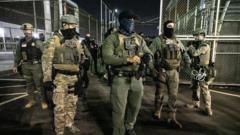A Boeing 747 gifted by Qatar is set to be integrated into the U.S. Air Force One fleet, despite controversy and criticisms about the legality of accepting such a gift due to the Emoluments Clause.
Controversy Surrounds Acceptance of Qatari Gift to Air Force One Fleet

Controversy Surrounds Acceptance of Qatari Gift to Air Force One Fleet
The U.S. has officially accepted a Boeing 747 from Qatar for the Air Force One fleet, raising concerns regarding legality and potential implications under the Emoluments Clause.
The United States has recently concluded an agreement to accept a Boeing 747 from Qatar, intended for future use in the Air Force One fleet. This decision has ignited a storm of criticism, including dissent from some of President Donald Trump's staunchest allies. Chief Pentagon spokesman Sean Parnell clarified that the Secretary of Defense has worked within federal regulations to facilitate the acquisition of the aircraft. While the plane requires modifications for presidential transport, its acceptance is framed as a legitimate act by the White House.
The Qatari royal family reportedly gifted the plane, valued at approximately $400 million (£300 million). Astoundingly, the White House has positioned the aircraft's transfer as a legal act, citing that it will ultimately be housed in Trump’s presidential library upon the conclusion of his presidency.
However, the acceptance of the aircraft has raised eyebrows relating to the U.S. Constitution's Emoluments Clause, which restricts public officials from receiving gifts from foreign nations without Congress's permission. Critics argue that the aircraft's transfer has not adhered to necessary congressional approval protocols.
In defending this move, President Trump has emphasized the generosity of the Qatari offer, suggesting that refusing such a gift would be unreasonable, even labeling it as “stupid.” Currently, the Air Force One fleet includes older 747-200 jets in operation since 1990 alongside smaller 757s. The integration of this new aircraft will likely require substantial financial resources for security upgrades and modifications, potentially leading to long-term implications for future presidential travel logistics.
This story continues to develop as further details emerge regarding the acceptance and future use of the aircraft. Follow for updates on this significant aviation development involving the U.S. presidency.





















